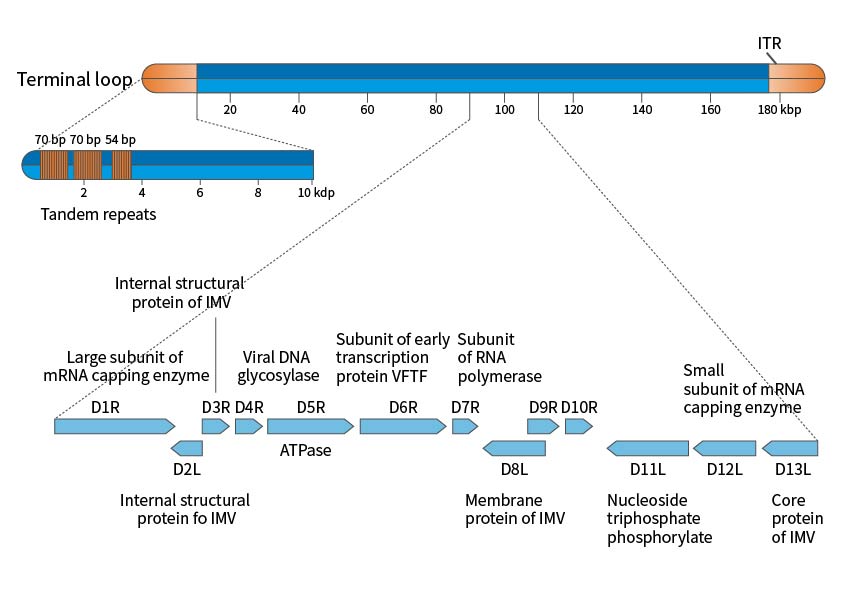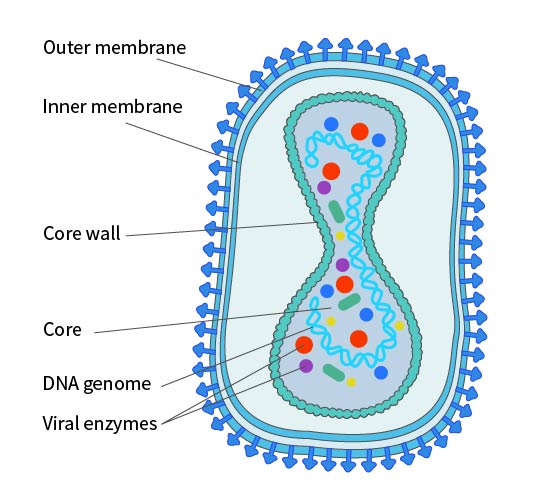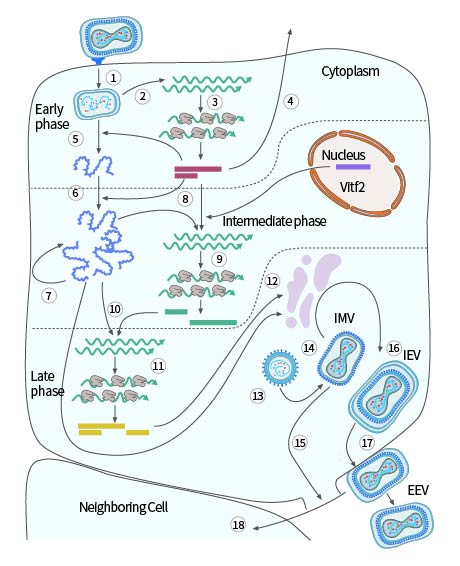Since the global eradication of smallpox in 1980, there has been little development of therapies for the variola virus. The global monkeypox outbreak in 2022 brought smallpox back into public focus, raising concerns that variola or monkeypox viruses could become potential bioweapons of terrorism. The variola virus and the monkeypox virus (MPXV) both belong to the Poxviridae family, Chordopoxvirinae subfamily, and Orthopoxvirus genus. Poxviruses are the largest known animal viruses, capable of infecting most vertebrates and invertebrates. They are double-stranded DNA viruses with about 200 distinct genes. A subset of these gene products can independently perform essential viral functions without the host cell nucleus, while others widely regulate the host cell and immune system.
Notable orthopoxviruses in human epidemiology include variola virus, vaccinia virus (VACV), cowpox virus (CPXV), and monkeypox virus (MPXV). Variola virus, the causative agent of smallpox, has two clinical epidemiological variants identified in the United States: Variola major virus and Variola minor virus (or alastrim virus), with fatality rates of 5-40% and 1%, respectively, indicating greater virulence of the Variola major virus. The cowpox virus was named for its association with pustular lesions on cow udders and milkmaids' hands. Interestingly, cows are not the natural host of CPXV, and cowpox is not a common disease. The vaccinia virus is widely used as a poxvirus model in laboratories and was used to produce smallpox vaccines, with strains like M-63 (Soviet Union), Lister (UK), Tiantan (China), and Wyeth, IHD (USA) being most commonly used.
The poxvirus genome is a linear double-stranded DNA with variable-length inverted terminal repeats forming hairpin structures. The full sequencing of vaccinia virus Copenhagen and WR strains shows a genome length of 191kbp, with 12kbp inverted terminal repeats (ITR) ending in covalently connected single-stranded hairpin loops. The sequence is AT-rich and contains short direct repeats and multiple ORFs. Poxviruses can replicate entirely in the cytoplasm, with low dependence on the host cell's DNA and RNA. The virus synthesizes new genes by generating and breaking down large tandem molecules, providing favorable conditions for genome amplification and evolution by acquiring new functions.

Figure 1. Schematic Diagram of the Vaccinia Virus Genome
Poxviruses are the most structurally complex known viruses, with elliptical or brick-like particles about 200-400nm long and an aspect ratio of 1.2-1.7. The membrane is a typical 50-55nm lipid-protein bilayer, surrounding the core and covered with randomly arranged tubular elements (STE), averaging 7nm wide and 100nm long. The virus particle consists of a core and related lateral bodies surrounded by a membrane, making it sufficiently infectious; however, for some virus strains and specific cell infections, the virus particle may acquire an additional lipid bilayer with a unique chemical composition, called the Envelope. This Envelope contains about twice the phospholipids of the non-enveloped virus particle. Studies have shown that antigens on the viral envelope can induce immunity, protecting the host from poxvirus infection. The poxvirus envelope contains at least seven different glycoproteins and a major non-glycosylated acylated polypeptide.

Figure 2. Structural Diagram of Poxvirus in IMV Form. Note: The existence of an inner membrane is still under debate.
The transmission process varies significantly depending on the poxvirus species and host, usually involving the following methods: 1) remaining free in the cytoplasm; 2) migrating to the cell surface and being expelled through microvilli; 3) being enveloped by a double membrane from the Golgi apparatus, transported to the cell surface, and released by an envelope (from the Golgi apparatus intraluminal pool membrane); 4) forming large vesicles through budding and acquiring an envelope; 5) combining with non-membrane vesicles; 6) combining with a protein substance in an acidophilic cytoplasmic structure called an a-type inclusion body (ATI).
The poxvirus replication cycle varies by virus species. Using the model virus VACV as an example, replication generally occurs 2-5 hours post-infection. Viral maturation occurs in five stages: immature virion (IV), intracellular mature virion (IMV), intracellular enveloped virion (IEV), cell-associated enveloped virion (CEV), and extracellular enveloped virion (EEV). IMV and EEV are the main infectious forms of vaccinia virus, with EEV being more infectious and entering cells through a non-pH-dependent membrane fusion process. EEV is responsible for intercellular transmission, eventually released as IMV into the external environment. Compared to EEV, IMV is more stable and responsible for inter-host transmission.
After fusion with the cell membrane, primary uncoating occurs, releasing the viral core into the cytoplasm. The core contains the viral genome, along with virus-dependent RNA polymerase, "initiation" proteins necessary for specific recognition of viral early gene promoters, and several RNA processing enzymes that modify viral transcripts. After release, the core synthesizes viral early mRNA (Step 2 in Figure 3), which exhibits the typical characteristics of cellular mRNA, being recognized and translated by the cell (Step 3 in Figure 3). About half of the viral genes are expressed early in infection. Some early proteins, similar in sequence to cellular growth factors, are secreted from the cell (Step 4 in Figure 3), inducing the proliferation of neighboring host cells or the suppression of host immune defense mechanisms. The synthesis of early proteins induces secondary uncoating, the core wall opens, and the nucleoprotein complex containing the genome is released from the core (Step 5 in Figure 3), halting the expression of viral early genes.
Early proteins catalyze the replication of the viral DNA genome (Step 6 in Figure 3), and the newly synthesized viral DNA molecules serve as templates for the next replication cycle (Step 7 in Figure 3) and as templates for the transcription of viral intermediate genes (Step 8 in Figure 3). Intermediate gene transcription requires specific viral proteins (products of early genes) that confer specificity for intermediate promoters on the viral RNA polymerase and host cell proteins (Vitf2) relocated from the infected cell nucleus to the cytoplasm. Intermediate mRNA encodes proteins (Step 9 in Figure 3), including those needed for late gene transcription (Step 10 in Figure 3). Late genes encode proteins that construct the virus particle, enzymes, and other early initiation proteins needed for virus particle assembly. These viral proteins are synthesized with the help of the cellular translation mechanism (Step 11 in Figure 3).
Viral membrane proteins are non-glycosylated, and the role of the cellular membrane in early assembly is controversial (Step 12 in Figure 3). Initial assembly forms immature virus particles (Step 13 in Figure 3), spherical particles separated by a membrane, possibly obtained from the early secretion pathway of the cell. The virus particle matures into brick-shaped IMV (Step 14 in Figure 3), released upon cell lysis (Step 15 in Figure 3). Additionally, the particles can acquire a second bilayer from the Golgi apparatus or early endosome, forming intracellular enveloped virus particles (IEV) (Step 16 in Figure 3).
IEV moves to the cell surface on microtubules, fusing with the plasma membrane to form cell-associated virus particles (CEV) (Step 17 in Figure 3). These CEV induce actin polymerization, promoting the direct transfer of actin to surrounding cells (Step 18 in Figure 3); they can also separate from the membrane to form EEV.

Figure 3. Single-cell reproduction cycle of vaccinia virus
References
1.Buller RM, Palumbo GJ. Poxvirus pathogenesis. Microbiol Rev. 1991, 55(1): 80-122.
2.Harrison SC, Alberts B, Ehrenfeld E, et al. Discovery of antivirals against smallpox. Proc Natl Acad Sci U S A. 2004, 101(31): 11178-11192.
 免费任你躁国语自产在线播放
|
国产精品高潮久久久久无码
|
一级毛片在线看在线播放
|
免费女人18a级毛片视频
|
成人网站免费大全日韩国产
|
特级做A爰片毛片免费看无码
|
精品国内自产拍在线观看
|
动漫黄网站免费永久在线观看
|
国产AV一区二区三区
|
国产又滑又嫩又白
|
日韩超碰人人爽人人做人人天
|
每日更新在线观看av
|
少妇被黑人到高潮喷出白浆
|
亚洲欧洲校园自拍都市
|
最近中文字幕在线中文高清版
|
放荡的小峓子2中文字幕
|
亚洲国产另类久久久精品
|
国内精品久久久久影院久久久91
|
CHINESE熟女老女人HD视频
|
九九视频免费精品视频免费
|
精品人妻少妇嫩草AV无码专区
|
国产爱豆剧传媒在线观看
|
日本久久精品视频
|
国产精品一区二区在线播放
|
色欲精品国产一区二区三区AV
|
久久婷婷五月综合色丁香
|
青青草a国产免费观看
|
久久久久国产一级毛片高清版小说
|
免费va国产高清大片在线
|
精品人妻少妇久久久AV
|
亚洲AV优女天堂波多野结衣
|
欧美日韩视频一视频二视频三
|
亚洲伊人久久综合影院2021
|
国产主播AV福利精品一区
|
日本强好片久久久久久AAA
|
亚洲欧美二区三区久本道
|
国产精华液一级毛片久久久久久久女人18
|
性色爽爱性色爽爱网站
|
亚洲欧美日韩国产专区一区
|
精品精品国产三级A∨在线
**色毛片免费观看
色欲日本人妻久久久久久综合
|
国产欧美久久久久久精品一区二区
|
免费任你躁国语自产在线播放
|
国产精品高潮久久久久无码
|
一级毛片在线看在线播放
|
免费女人18a级毛片视频
|
成人网站免费大全日韩国产
|
特级做A爰片毛片免费看无码
|
精品国内自产拍在线观看
|
动漫黄网站免费永久在线观看
|
国产AV一区二区三区
|
国产又滑又嫩又白
|
日韩超碰人人爽人人做人人天
|
每日更新在线观看av
|
少妇被黑人到高潮喷出白浆
|
亚洲欧洲校园自拍都市
|
最近中文字幕在线中文高清版
|
放荡的小峓子2中文字幕
|
亚洲国产另类久久久精品
|
国内精品久久久久影院久久久91
|
CHINESE熟女老女人HD视频
|
九九视频免费精品视频免费
|
精品人妻少妇嫩草AV无码专区
|
国产爱豆剧传媒在线观看
|
日本久久精品视频
|
国产精品一区二区在线播放
|
色欲精品国产一区二区三区AV
|
久久婷婷五月综合色丁香
|
青青草a国产免费观看
|
久久久久国产一级毛片高清版小说
|
免费va国产高清大片在线
|
精品人妻少妇久久久AV
|
亚洲AV优女天堂波多野结衣
|
欧美日韩视频一视频二视频三
|
亚洲伊人久久综合影院2021
|
国产主播AV福利精品一区
|
日本强好片久久久久久AAA
|
亚洲欧美二区三区久本道
|
国产精华液一级毛片久久久久久久女人18
|
性色爽爱性色爽爱网站
|
亚洲欧美日韩国产专区一区
|
精品精品国产三级A∨在线
**色毛片免费观看
色欲日本人妻久久久久久综合
|
国产欧美久久久久久精品一区二区
|